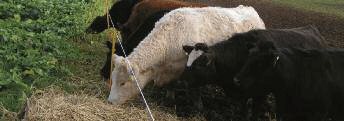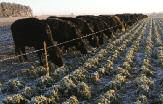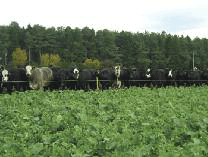



Cattle Outwintering Systems
This feature describes out-wintering systems for suckler cows based on trials conducted in a wide range of environments by Quality Meat Scotland and SAC (Scottish Agricultural College).The objective of these trials was to reduce feed and labour costs by minimising the time cattle spend in buildings in the winter.
Many Scottish farms can grow brassica crops with the potential to reduce costs, but not all can out-winter cattle successfully on them due to constraints of soil type and the need to meet cross compliance objectives and maintain animal welfare.
The need for action
Beef cow numbers in Scotland are predicted to fall to 445,000 in 2009, a 16% reduction since 1998. Many farmers have reduced herd size because of low profitability, and changes in the support system are also a factor in declining cow numbers. In hill and upland areas many farmers are relying on Less Favoured Area Support Scheme payments and there is no doubt changes in support measures are needed to maintain the Scottish beef herd.
Net margins per suckler cow range from -£150 to -£250 for herds taking calves to weaning, excluding subsidy payments; future profitability for the sector as a whole will depend on increasing returns and reducing costs.

Systems of out-wintering can be based on either grass that has been deferred from grazing, or forage brassica crops supplemented with conserved forage. In either case, animals are spending less time inside, harvesting their own resources and spreading their own dung – all of which leads to significant savings in labour, machinery, fuel, bedding and feed costs, and with the added advantage of better animal health and welfare.
By illustrating the potential for out-wintering, it is hoped that this booklet will encourage farmers to maintain cow numbers and – as a result – build their share of the UK beef market.
 |
 |
|---|
Potential advantages of out-wintering
- Reduced costs of straw bedding and machinery.
- Reduced wintering costs for all or part of the winter.
- Availability of cow housing for alternative uses (e.g. finishing more cattle).
- Reduced exposure to store market volatility as more shed space available.
- Increased health status (e.g. reduced pneumonia risk).
- Easier calving (reduced build up of infection, improved cow condition).
- Reduction of damage to soils through tracking.
- Even, efficient and low cost distribution of manure.
- Cattle appear content and healthy.
- Less labour time.
- Better working environment away from dust etc.
Objectives
For cattle to be out-wintered successfully on any system, welfare and prevailing environmental conditions must be considered. Failure to adhere to welfare or cross compliance measures could potentially have an impact on the Single Farm Payment, if penalties are imposed.
Prior to decisions being made it is advised that discussions take place with local agricultural officers and relevant environmental officers, which is important when land is under certain conditions such as SSSIs.
The importance of the out-wintering decision is not simply to compare out-wintering systems versus housing, but to look at the potential for farms to reduce housing time and assess the labour saving implications.

All systems demonstrated are based on partial out-wintering as the spring calving cows are normally housed one month prior to calving for management purposes. This is not a new concept, but one that has again become more relevant.
The decision to out-winter will depend on a combination of soil type, climate and breed of cattle, and the scale of the enterprise is also important. Hill and upland farmers with hardy breeds of cattle capable of withstanding severe climate constraints will be attracted to out-wintering on deferred grazing. Upland and lowland farmers in drier areas (less than 1000 mm [40 inches] of rainfall) and where soil types are loamy rather than clay-based, may consider growing forage brassicas to out-winter either cows or youngstock. The larger arable farmer with suckler cows may consider putting cows out for part of the winter on stubble turnips grown as a catch crop following cereals.
All results described in this booklet were achieved depending on that specific year’s growing season.
Further Reading
| - | View the results of the trials by clicking here. |
May 2009



